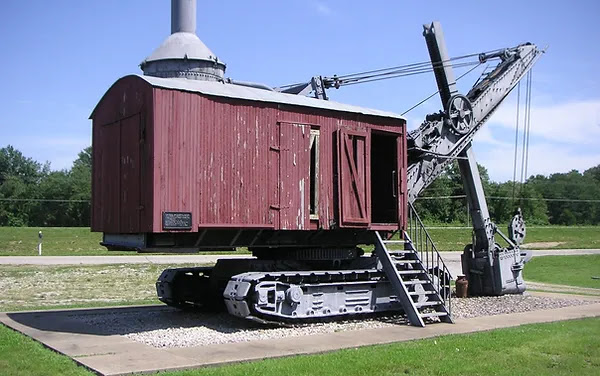Shovel: (
Satellite)
Roundhouse: (
Satellite, remnants of the foundation are visible.)
KCS = Kansas City Southern
 |
CrawfordCountyMuseum
The first underground mine was started in 1917. The Wilkinson Coal Co. started another one in 1923 one mile north of Weir City.
In 1935, it became evident strip mining was more profitable and the company purchased a Marion Model #37 Steam Shovel from the Joe Klaner Coal Company in Detroit and moved it to southeast Kansas. The Steam Shovel was in operation until 1953. In 1938, a 222 Page Dragline was purchased and moved from Louisiana to Weir City, Kansas where it was re-assembled and put into operation. A Walking 618 Page Dragline was purchased in 1953 from Alexandria, Louisiana and shipped by rail to Weir City from the strip mining operation. The dragline was later used for clay mining by the Mission Clay Company. In 1963, a grass fire touched off an explosion in a powder magazine at the mine. Four people were injured including Mr. and Mrs. Morris Wilkinson, and their son Bill. The fire department[s] from the communities of Pittsburg, Galena, Baxter Springs, Columbus, and Asbury came to the rescue. The explosion destroyed the tipple, machine shop, the scale house, two storage buildings and nine company trucks. The Wilkinson Coal Company continued to mine coal in Cherokee County until 1979 when EPA regulations required blending Southeast Kansas coal with Wyoming coal for a cleaner blend. It was no longer profitable to continue operation. |
"Galena, Baxter Springs and Treece in southeastern Cherokee County were found to be rich in lead and zinc. The area became part of the Tri-State Lead and Zinc Mining District, which includes parts of southwest Missouri and northeast Oklahoma. During the first half of the 20th century the Tri-State District was the world’s leader in zinc production....By the time the last lead and zinc mines closed in Cherokee County in 1970 nearly 2.9 million tons of zinc and 700,000 tons of lead had been produced, according to KGS." [
MinersHallMuseum via
Dennis DeBruler]
I don't know if this is a lead+zinc mine or a coal mine. Mining coal started underground in southeast Kansas, but then strip mining became prevalent.
I could not pass up the spelling of US Mail as US Male.
 |
Tim Starr posted
Shops and roundhouse terminal of the Kansas City Southern at Pittsburg KS (Railway Master Mechanic, 1908) |
Look at all of the strip mines in the area. No wonder the town has a steam shovel.
 |
| 1950/50 Pittsburg Quad @ 62,500 |








No comments:
Post a Comment